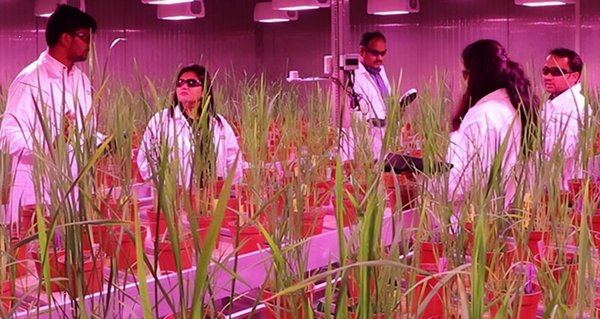 Read this article in French
Read this article in French- Share this article
- Subscribe to our newsletter
IRRI develops first speed-breeding protocol for rice
To increase rice yields and feed billions of people, it is essential to enhance genetic gains. However, the development of new varieties is hindered by longer generation times and seasonal constraints.
To address these limitations, a speed breeding facility has been established, and a robust speed breeding protocol, SpeedFlower has been developed that allows growing four to five generations of indica and/or japonica rice in a year. This protocol will be important to accelerate breeding new improved varieties of rice to cope with climate change and the needs of a growing world population.
Called SpeedFlower, the protocol focuses on optimising light spectrum, amount and intensity, along with temperature, humidity and other variables that expedite growth, flowering and maturity in rice. The protocol is suitable for the vast majority of rice grown globally, including for indica and japonica rice.
“We can now develop new high-yielding, climate-resilient, and nutritionally superior rice varieties in a much shorter duration. This is a major scientific step toward significantly boosting genetic gain in rice, ultimately contributing to global food security,” said programme lead Drs Vikas Kumar Singh, Uma Maheshwar Singh and Pallavi Sinha.
The success of speed breeding in other crops led to the establishment of a state-of-the-art SpeedBreed facility at ISARC (IRRI South Asia Regional Centre) in Varanasi, India. To achieve speed breeding in rice, the facility has been customised with controlled growth parameters, using fully enclosed walk-in growth chambers.
SpeedFlower described
The protocol focuses on optimising light spectrum, intensity, photoperiod, temperature, humidity, nutrient levels and hormonal regulation to expedite growth, flowering and maturity in rice. It has demonstrated flowering within just 60 days for tested rice varieties and achieved a 50 per cent reduction in seed maturity time, irrespective of their natural flowering durations.
A subset of 198 genotypes, representing twelve diverse sub-groups of Oryza sativa L. from the 3,000 Rice Genomes Project (3K RGP), was selected to validate the optimised SpeedFlower in the speed breeding facility at ISARC. The subset was chosen based on the molecular diversity of the genotypes and their different flowering durations and geographic locations. In field conditions, their flowering time ranged from 58 to 127 days.
However, when grown under the optimised SpeedFlower, all 198 genotypes successfully flowered within a shorter period of 58 days. The protocol's significant reduction in flowering time for photosensitive and late-duration genotypes, along with remarkable synchronisation among segregating generations, addresses a major bottleneck in breeding programmes.
The SpeedBreed Facility and the innovative SpeedFlower protocol mark a significant leap in rice breeding, addressing generation time and seasonal constraints. The optimised protocol works for all the maturity durations (early, medium and late) of indica and japonica rice and enables synchronous flowering.
Partnerships for SpeedBreed and SpeedFlower
Considered as a model facility for speed breeding in rice, IRRI plans to establish a consortium to offer support services to National Agricultural Research and Extension Systems (NARES) and private companies on establishing and operating speed breeding facilities.
The protocol will be further refined for enhanced output, and comprehensive testing will be done to a broader range of rice genotypes. The programme proponents aim to further collaborate with NARES, including other centres under CGIAR, to leverage shared knowledge and expertise towards optimising the protocol for other crops.
“We continue to push research boundaries to develop innovations that are urgently needed in light of a growing food and climate crises. This breakthrough sets the new standard toward accelerating genetic gains for global food security,” said IRRI Interim Director General, Dr Ajay Kohli.
(IRRI/wi)
Reference: Vikas Kumar Singh, Uma Maheshwar Singh, and Pallavi Sinha: SpeedFlower: a comprehensive speed breeding protocol for indica and japonica rice; first published: 09th December 2023; Plant Biotechnology Journal. DOI: https://doi.org/10.1111/pbi.14245





Add a comment
Be the First to Comment